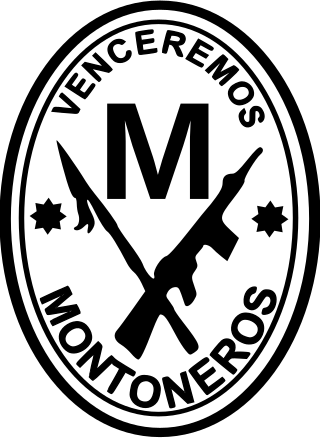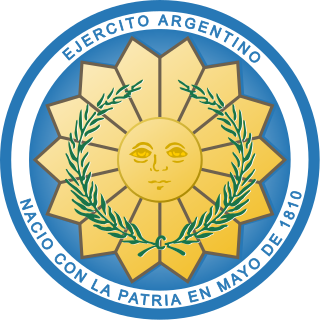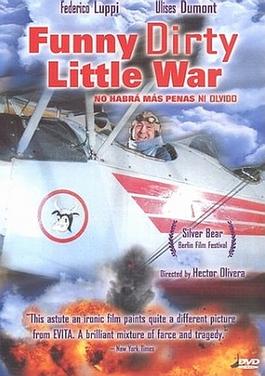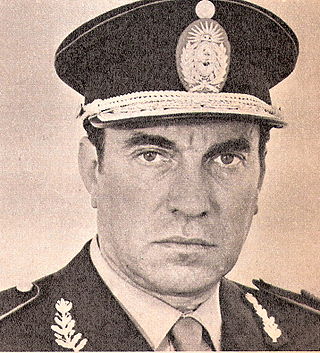
Montoneros was an Argentine far-left Peronist and Catholic revolutionary guerrilla organization, which emerged in the 1970s during the "Argentine Revolution" dictatorship. Its name was a reference to the 19th-century cavalry militias called Montoneras, which fought for the Federalist Party in the Argentine civil wars. Radicalized by the political repression of anti-Peronist regimes, the Cuban Revolution and socialist worker-priests committed to liberation theology, the Montoneros emerged from the 1960s Catholic revolutionary guerilla Comando Camilo Torres as a "national liberation movement", and became a convergence of revolutionary Peronism, Guevarism, and the revolutionary Catholicism of Juan García Elorrio shaped by Camilism. They fought for the return of Juan Perón to Argentina and the establishment of "Christian national socialism", based on 'indigenous' Argentinian and Catholic socialism, seen as the ultimate conclusion of Peronist doctrine.

Jorge Rafael Videla was an Argentine military officer and dictator, Commander in Chief of the Army, member of the Military Junta, the 47th President of Argentina, and the 1st President of the National Reorganization Process from 1976 to 1981. His rule, which was during the time of Operation Condor, was among the most infamous in Latin America during the Cold War due to its high level of human rights abuses and severe economic mismanagement.

Alejandro Agustín Lanusse was the de facto president of the Argentine Republic between March 22, 1971, and May 25, 1973, during the military dictatorship of the country called the "Argentine Revolution".

The People's Revolutionary Army was the military branch of the communist Workers' Revolutionary Party in Argentina.

Trelew is a city in the eastern part of the Chubut Province of Argentina. Located in Patagonia, the city is the largest and most populous in the low valley of the Chubut River, with 97,915 inhabitants as of 2010. The Trelew municipality is part of the Rawson Department, whose capital, Rawson, is also the provincial capital.

The Argentine Army is the land force branch of the Armed Forces of the Argentine Republic and the senior military service of Argentina. Under the Argentine Constitution, the president of Argentina is the commander-in-chief of the Armed Forces, exercising his or her command authority through the Minister of Defense.

The Workers' Revolutionary Party was a Marxist political party in Argentina, mainly active in the 1960s and 1970s. Currently there are different groups that claim to be a continuation of the historical PRT.

Tomás Eloy Martínez was an Argentine journalist and writer.
Enrique Haroldo Gorriarán Merlo was an Argentine guerrilla leader, born in San Nicolás de los Arroyos, Buenos Aires Province.
The Margarita Belén Massacre took place during the Dirty War in Argentina. It involved the torture and execution of 22 Montoneros, some of whom were killed after surrendering and laying down their weapons near the town of Margarita Belén, Chaco Province, on 13 December 1976, in a joint operation of the Argentine Army and the Chaco Provincial Police. One of the victims of the massacre, Néstor Carlos Salas, is reported to have been a Montoneros commander and took part in a number of guerrilla operations. Argentina was at the time ruled by the National Reorganization Process.

Funny Dirty Little War is a 1983 Argentine comedy-drama film directed by Héctor Olivera, written by Olivera and Roberto Cossa, based on a novel of the same name by Osvaldo Soriano. It was produced by Fernando Ayala and Luis O. Repetto, and stars Federico Luppi, Miguel Ángel Solá, Ulises Dumont, Héctor Bidonde and Víctor Laplace.

Operativo Independencia was a 1975 Argentine military operation in Tucumán Province to crush the People's Revolutionary Army (ERP), a Guevarist guerrilla group which tried to create a Vietnam-style war front in the northwestern province. It was the first large-scale military operation of the Dirty War.

Almirante Marcos A. Zar Airport is an airport in Trelew, Chubut Province, Argentina, named after the Argentine Navy Admiral and aviator Marcos Andrés Zar. The airport serves the cities of Trelew and Rawson.

Argentine Revolution was the name given by its leaders to a military coup d'état which overthrew the government of Argentina in June 1966 and began a period of military dictatorship by a junta from then until 1973.

Francisco "Paco" Urondo was an Argentine writer and member of the Montoneros guerrilla organization.

Mario Roberto Santucho was an Argentine revolutionary and guerrilla combatant, founder of the Partido Revolucionario de los Trabajadores and leader of Argentina's largest Marxist guerrilla group, the Ejército Revolucionario del Pueblo.

Antonio Domingo Bussi was an army general during the military dictatorship in Argentina and a politician prominent in the recent history of Tucumán Province, Argentina. He was tried and convicted for crimes against humanity.
The Battle of Acheral was fought near the San Gabriel stream, some 3 km away from the small town of Acheral, Tucumán province, Argentina. It was a turning point in the Operativo Independencia, a domestic Argentine military intervention aimed at eradicating guerrilla activities in Tucumán province, as well as eliminating so-called subversive elements. This action received nationwide media coverage due to the presence of two journalists from Gente magazine at the time.
Mario Abel Amaya was an Argentine lawyer and politician, reformist activist at the university and a member of the Radical Civic Union that was arrested-disappeared in 1976 by the V Army Corps based in Bahía Blanca, dying as a result of the torture to which it was subjected. In 1973 he was elected a national deputy in his district of the Province of Chubut, holding office until the coup of March 24, 1976.

The ERP-22 de Agosto was an Argentinian guerrilla faction split in 1973 of the Military Committee of the Federal Capital of the People's Revolutionary Army (ERP), as a result of tactical divergences regarding the organization's position before the electoral act of March 11, 1973.
















